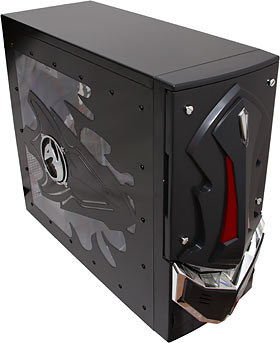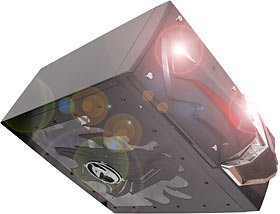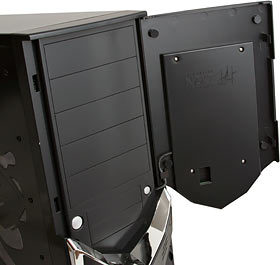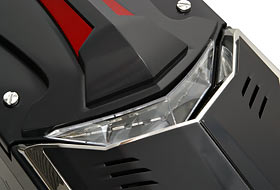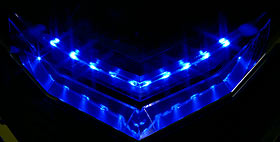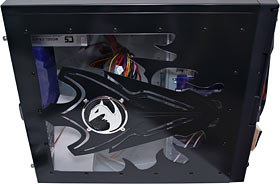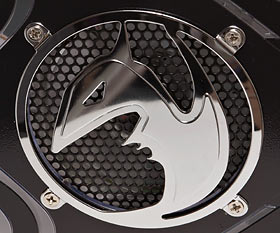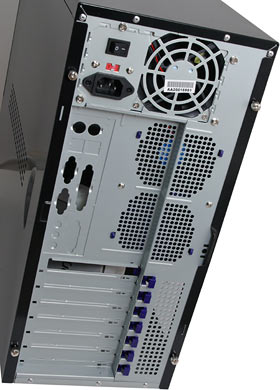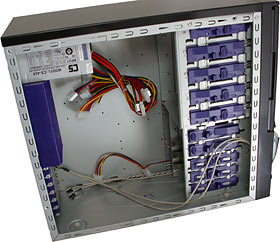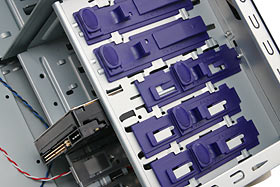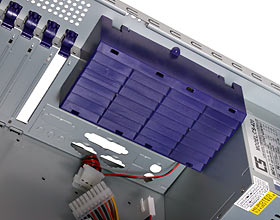
NZXT Guardian PC case
Review date: 7 May 2004.Last modified 03-Dec-2011.
Most computer cases are boring and beige.
Some computer cases are slick and silver.
Some computer cases come in basic black, or even stylish designer hues.
NZXT have no time for such things.
They make cases that look like this.
Actually, they're probably meant to look more like this.
NZXT's only PC enclosure at the moment is this one, the "Guardian", which comes in a variety of colours. When I first wrote this review, Aus PC Market here in Australia only stocked the black, silver and blue variants, but now they've got the lot, including green and yellow.
The Guardian I reviewed sold for $AU176, including a 420 watt Power Supply Unit (PSU) and Sydney metropolitan delivery (delivery elsewhere in the country costs more). Now you can also buy Guardians from Aus PC without a PSU; they're $AU132. Buy a Guardian with a brand name PSU and you'll be paying more than you would for the PSU-included version, but I'd be more confident about a "300 watt" AOpen or Antec than the "420 watt" NZXT no-brander.
PSU expenses aside, even after adding a bit more for delivery outside Sydney, you're not talking a fortune. These are not high priced cases.
At first sight, the Guardian looks like just another novelty-for-the-sake-of-it exercise in over-the-top design. A lot of cheap steel cases with tons of plastic sticking out of the front have come and gone over the years. The plastic, cheesy though it is, is usually the best thing about them.
Fortunately, the NZXT Guardian is actually a perfectly good box to put your PC in, with some genuinely innovative features. Yes, it's got a lot of plastic, and yes, it's made of steel (unloaded weight 7.1 kilograms), but that's where it parts company with the dressed-up-rubbish brigade.
The guided tour
You really can't miss that great big plastic nose.
The Guardian's front panel has a kind of medieval-Protoss-armour aesthetic about it. It looks quite impressive, if you like that sort of thing. It's certainly nicely finished; the chromed parts are magnificently shiny, and there are no paint or dye mistakes.
This front bezel is, as you'd expect, pretty much a complete pose. It has no real function beyond looking bad-ass. The four big silver slotted screw-heads on it sum up the whole thing; they're plastic, and permanently attached.
Well, unless you try to unscrew them.
Since I know how to use CA, nobody will ever know which one I naively took a screwdriver to.
The middle of the imposing front bezel protrudes at least a couple of inches further than the average plastic bezel, which makes it vulnerable to packing and shipping damage. So, in addition to the traditional big baby-suffocating plastic bag and two polystyrene foam endpieces, the Guardian also comes with some masking tape stuck to the front edges of the bezel, and a couple more little pieces of tape near the front door latches, presumably to stop the door being banged against the bezel in transit and scuffing it.
Accordingly, your NZXT fancy-case seems very likely to arrive in pristine condition.
Two little sliding doors on either side of the front mask's chin give access to front USB and audio ports.
To get at the drive bays and the power and reset buttons, you swing open the top portion of the mask.
A respectable five 5.25 inch bays, and two externally accessible 3.5 inch bays. The only bay with much clearance in front of it is the very top 5.25 inch one, though, so people who want to install tweaky fan controllers and such with protruding knobs may be foiled by the door.
But wait - there's more!
The red panels on the sides of the case-front helmet light up; they're the hard drive light. That ain't nothin' compared with the power light, though.
The helmet's visor is clear, with a chromed reflector under it, and a bent row of LEDs inside.
Powered up, it looks like this.
Well, it looks like this when all of the LEDs are on at once. On power-up, they start chasing in a selection of different patterns, and keep that up for a few minutes. Then they settle down to a few minutes of steady glowing while you regain your sanity. Then they start chasing again.
I could shoot a video clip of the chase effects, but NZXT have already done it; you can download the clip here. The professional videographer responsible shot the clip in the dark with autofocus turned on, but it still conveys the general stoned-Cylon nature of the light show.
The Guardian's extra-thorough packaging also extends to a big sheet of sticky plastic over...
...the side window.
It's got a kind of arrowhead... flamey... batwing... uh, thing... going on, which is certainly more interesting than the bland rectangular windows of more staid show-off cases.
Behind the side window's shiny emblem and less shiny grille, there's a clear intake fan lit by red, green and blue LEDs.
The back of the Guardian looks almost normal. Thumbscrews hold on the side panels, but that's not at all odd these days. The two exhaust fan grilles (in addition to the fan in the PSU) are stepped, which doesn't look as if it ought to work. And there's a row of funny purple things next to the expansion slot holes...
Peering inside shows some more purple plastic.
The Guardian's basic interior specs are fine, but unremarkable. Five 5.25 inch bays, as mentioned above, and five 3.5 inchers, counting the two that're externally accessible. Standard ATX motherboard mounting area with no slide-out tray, dangly header wires for the front ports - all of which are fed by pin headers, not passthrough plugs, so you'll need a motherboard with audio headers on it to use the front sound connectors.
The standard PSU's sticker ratings are normal for a cheap allegedly-420-watt unit; the 3.3, 5 and 12V rails that're all that really matter score 72.6, 175 and 180 watts respectively, which'd give an overall rating of better than 420 power-rail watts if not for the small print that specifies no more than 210W total load for 3.3 and 5V together.
So that's 390 real power rail watts, assuming the sticker's accurate, which it's probably somewhat close to being. I'd bet on this PSU running anything that a name-brand "300 watt" PSU could run, but it might not last as long. It'll be fine for anything that almost all buyers are going to pack into a Guardian, but it doesn't cost a whole lot to get something a bit fancier; Aus PC sell 350W Antec PSUs (with a light-up exhaust fan!) for less than $AU90 delivered.
The standard PSU's output connectors are OK, too. ATX and ATX12V, of course, plus the little-used-on-consumer-boards "AUX" plug, six "Molex" drive power plugs, and two floppy power plugs. Which, these days, might more accurately be called "video card power plugs".
The Guardian's front lights and side and back fans all run from passthrough power connectors, so they won't rob you of any drive plugs.
So that's it for the standard stuff. Now for the purple.
First purple - all those weird things on the sides of the drive bays. They're a rather elegant slide-clamp arrangement that lets you mount and unmount drives by simply sliding the plastic back and forth. The 5.25 inch bay clamps are all the same; the 3.5 inch bay clamps come in two flavours, with ones that suit floppy drives for the two externally accessible bays, and ones that suit hard drives for the other three.
I wouldn't rely on the clamps to hold a drive in a LAN party machine that's going to get nudged and shaken and, possibly, knocked over now and then, but for domestic purposes they seem very secure. If you're not convinced, you can still use screws.
Second purple - the louvred exhaust fan enclosure at the back, which explains that weird stepped grille.
The enclosure is only populated with one fan as standard equipment, and the louvres can't help but eat some airflow. But it's a neat clip-in design, and it'd only be the work of a couple of minutes to snip out all of the louvres if you wanted to shift more air.
There's also no front intake fan as standard equipment, but there's a space for one, in front of the 3.5 inch bays where you'd expect it.
The Guardian's standard fan complement should be perfectly adequate for most people; they're all low-to-medium-power units that'll keep the noise down to a dull roar. If you're installing a few 3.5 inch drives or flying the friendly skies of extreme overclocking, though, it'd be worth adding at least a front fan.
Third purple - the expansion card thingies. More clips, and darned elegant ones, too; they pop up easily (the one next to the card in the above picture is in the up position), but lock down positively, and they are to expansion cards what the drive clamps are to storage devices.
Which is to say, the clips are all you'll need to hold cards in place, unless you expect the computer to have to endure rough treatment. If that's the case, no problem; the clips don't get in the way of the card retaining screw hole. Lovely.
Overall
Features like the Guardian's drive and expansion card clips, in cheap-ish cases like this one, usually turn out to be nothing but annoying gimmicks.
The Guardian's extra features actually work, though. I'm impressed.
This is obviously not a computer enclosure for everyone, even if you don't plug in the front panel lights. But it's surprising how good an enclosure it really is - and, speaking objectively about its fit and finish and not subjectively about its particular aesthetic direction, it's a really well executed product. It doesn't rattle or squeak or jam, its paintwork is slick, and the ludicrous front panel was clearly not created by people who thought it was a bad idea.
If you're looking for a fast and painless leg-up into the case modding world, the NZXT Guardian is it, at a reasonable price. If prettified cases aren't quite your cup of tea, though, the Guardian's extra features still make it oddly alluring, considering its low price.
Recommended.
Buy stuff!
Aus PC Market no longer sell this case, but they've got
lots of others!
